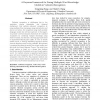Free Online Productivity Tools
i2Speak
i2Symbol
i2OCR
iTex2Img
iWeb2Print
iWeb2Shot
i2Type
iPdf2Split
iPdf2Merge
i2Bopomofo
i2Arabic
i2Style
i2Image
i2PDF
iLatex2Rtf
Sci2ools
CVPR
2003
IEEE
2003
IEEE
A Bayesian Framework for Fusing Multiple Word Knowledge Models in Videotext Recognition
Videotext recognition is challenging due to low resolution, diverse fonts/styles, and cluttered background. Past methods enhanced recognition by using multiple frame averaging, image interpolation and lexicon correction, but recognition using multi-modality language models has not been explored. In this paper, we present a formal Bayesian framework for videotext recognition by combining multiple knowledge using mixture models, and describe a learning approach based on Expectation-Maximization (EM). In order to handle unseen words, a back-off smoothing approach derived from the Bayesian model is also presented. We exploited a prototype that fuses the model from closed caption and that from the British National Corpus. The model from closed caption is based on a unique time distance distribution model of videotext words and closed caption words. Our method achieves a significant performance gain, with word recognition rate of 76.8% and character recognition rate of 86.7%. The proposed m...
Character Recognition Rate | Closed Caption | Computer Vision | CVPR 2003 | False Alarm Rate | Methods Enhanced Recognition | Word Recognition Rate |
| Added | 12 Oct 2009 |
| Updated | 12 Oct 2009 |
| Type | Conference |
| Year | 2003 |
| Where | CVPR |
| Authors | DongQing Zhang, Shih-Fu Chang |
Comments (0)

